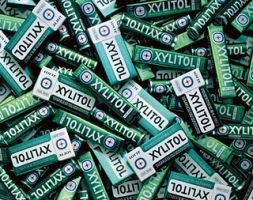The holidays have gone by, but many of us still have candies lying around the house. Xylitol is an artificial sweetener found in many chewing gums and other candies, and it is extremely toxic to dogs. We add xylitol to candy because it tastes like sugar, but our body does not digest it – it contains no calories. While it is safe for us, it is very dangerous for dogs.
How does xylitol hurt my dog?
Unlike us, when a dog ingests xylitol (such as by getting into a pack of gum), the dog’s body falsely recognizes it as a tremendous amount of sugar. This causes the dog’s pancreas to release a lot of insulin, as if the dog’s blood sugar were very high. Because it is not actually high, this increase in insulin causes a dangerous drop in blood sugar (hypoglycemia). While some dogs merely develop temporarily elevated liver enzymes, suffer from acute liver failure, hemorrhage, blood coagulation, and death.
How much xylitol is dangerous?
It takes only one or two pieces of gum to cause toxicity in a 10kg dog (about 22 lbs). If your dog eats chewing gum or a candy containing xylitol, you should immediately call Animal Poison Control at (888) 426-4435 or contact your veterinarian / an emergency clinic.
Is xylitol dangerous to cats?
We know little about how xylitol affects cats, but it may not be toxic. If your cat ingests xylitol, you should watch your cat carefully, but you do not need to call animal poison control.
Źródło: animalendocrine.blogspot.com
© 2024 © Vetco 2015. Wdrożenie: Pracownia Synergii











